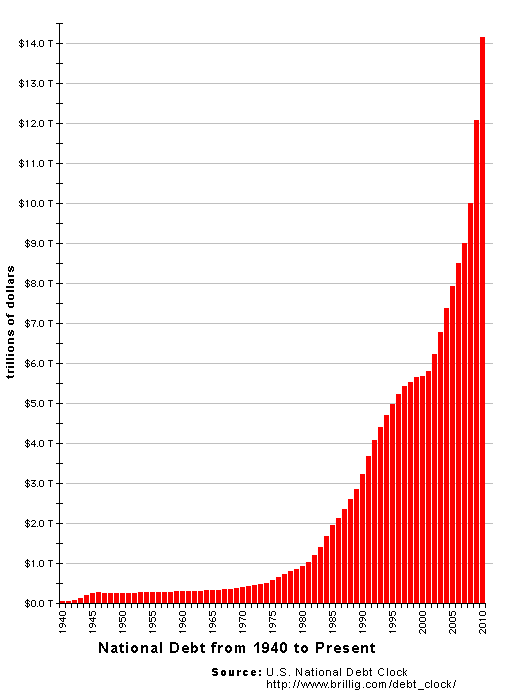 Over the past couple of years, most Americans have shown little concern as austerity measures were imposed on financially troubled nations across Europe. Even as austerity riots erupted in nations such as Greece and Spain, most Americans were still convinced that nothing like that could ever happen here. Well, guess what? Austerity has arrived in America. At this point, it is not a formal, mandated austerity like we have seen in Europe, but the results are just the same. Taxes are going up, services are being slashed dramatically, thousands of state and city employees are being laid off, and politicians seem to be endlessly talking about ways to make even deeper budget cuts. Unfortunately, even with the incredibly severe budget cuts that we have seen already, many state and local governments across the United States are still facing a sea of red ink as far as the eye can see.
Over the past couple of years, most Americans have shown little concern as austerity measures were imposed on financially troubled nations across Europe. Even as austerity riots erupted in nations such as Greece and Spain, most Americans were still convinced that nothing like that could ever happen here. Well, guess what? Austerity has arrived in America. At this point, it is not a formal, mandated austerity like we have seen in Europe, but the results are just the same. Taxes are going up, services are being slashed dramatically, thousands of state and city employees are being laid off, and politicians seem to be endlessly talking about ways to make even deeper budget cuts. Unfortunately, even with the incredibly severe budget cuts that we have seen already, many state and local governments across the United States are still facing a sea of red ink as far as the eye can see.
Most Americans tend to think of “government debt” as only a problem of the federal government. But that is simply not accurate. The truth is that there are thousands of “government debt problems” from coast to coast. Today, state and local government debt has reached at an all-time high of 22 percent of U.S. GDP. It is a crisis of catastrophic proportions that is not going away any time soon.
A recent article in the New York Times did a good job of summarizing the financial pain that many state governments are feeling right now. Unfortunately, as bad as the budget shortfalls are for this year, they are projected to be even worse in 2012….
While state revenues — shrunken as a result of the recession — are finally starting to improve somewhat, federal stimulus money that had propped up state budgets is vanishing and costs are rising, all of which has left state leaders bracing for what is next. For now, states have budget gaps of $26 billion, by some estimates, and foresee shortfalls of at least $82 billion as they look to next year’s budgets.
So what is the solution? Well, for state and local politicians from coast to coast, the answer to these financial problems is to impose austerity measures. Of course they never, ever use the term “austerity measures”, but that is exactly what they are.
The following are 22 signs that austerity has already arrived in America and that it is going to be very, very painful….
#1 The financial manager of the Detroit Public Schools, Robert Bobb, has submitted a proposal to close half of all the schools in the city. His plan envisions class sizes of up to 62 students in the remaining schools.
#2 Detroit Mayor Dave Bing wants to cut off 20 percent of the entire city from police and trash services in order to save money.
#3 Things are so tight in California that Governor Jerry Brown is requiring approximately 48,000 state workers to turn in their government-paid cell phones by June 1st.
#4 New York Governor Andrew Cuomo is proposing to completely eliminate 20 percent of state agencies.
#5 New York City Mayor Michael Bloomberg has closed 20 fire departments at night and is proposing layoffs in every single city agency.
#6 In the state of Illinois, lawmakers recently pushed through a 66 percent increase in the personal income tax rate.
#7 The town of Prichard, Alabama came up with a unique way to battle their budget woes recently. They simply stopped sending out pension checks to retired workers. Of course this is a violation of state law, but town officials insist that they just do not have the money.
#8 New Jersey Governor Chris Christie recently purposely skipped a scheduled 3.1 billion dollar payment to that state’s pension system.
#9 The state of New Jersey is in such bad shape that they still are facing a $10 billion budget deficit for this year even after cutting a billion dollars from the education budget and laying off thousands of teachers.
#10 Due to a very serious budget shortfall, the city of Newark, New Jersey recently made very significant cuts to the police force. Subsequently, there has been a very substantial spike in the crime rate.
#11 The city of Camden, New Jersey is “the second most dangerous city in America”, but because of a huge budget shortfall they recently felt forced to lay off half of the city police force.
#12 Philadelphia, Baltimore and Sacramento have all instituted “rolling brownouts” during which various city fire stations are shut down on a rotating basis.
#13 In Georgia, the county of Clayton recently eliminated its entire public bus system in order to save 8 million dollars.
#14 Oakland, California Police Chief Anthony Batts has announced that due to severe budget cuts there are a number of crimes that his department will simply not be able to respond to any longer. The crimes that the Oakland police will no longer be responding to include grand theft, burglary, car wrecks, identity theft and vandalism.
#15 In Connecticut, the governor is asking state legislators to approve the biggest tax increase that the state has seen in two decades.
#16 All across the United States, conditions at many state parks, recreation areas and historic sites are deplorable at best. Some states have backlogs of repair projects that are now over a billion dollars long. The following is a quote from a recent MSNBC article about these project backlogs….
More than a dozen states estimate that their backlogs are at least $100 million. Massachusetts and New York’s are at least $1 billion. Hawaii officials called park conditions “deplorable” in a December report asking for $50 million per year for five years to tackle a $240 million backlog that covers parks, trails and harbors.
#17 The state of Arizona recently announced that it has decided to stop paying for many types of organ transplants for people enrolled in its Medicaid program.
#18 Not only that, but Arizona is so desperate for money that they have even sold off the state capitol building, the state supreme court building and the legislative chambers.
#19 All over the nation, asphalt roads are actually being ground up and are being replaced with gravel because it is cheaper to maintain. The state of South Dakota has transformed over 100 miles of asphalt road into gravel over the past year, and 38 out of the 83 counties in the state of Michigan have transformed at least some of their asphalt roads into gravel roads.
#20 The state of Illinois is such a financial disaster zone that it is hard to even describe. According to 60 Minutes, the state of Illinois is six months behind on their bill payments. 60 Minutes correspondent Steve Croft asked Illinois state Comptroller Dan Hynes how many people and organizations are waiting to be paid by the state, and this is how Hynes responded….
“It’s fair to say that there are tens of thousands if not hundreds of thousands of people waiting to be paid by the state.”
#21 The city of Chicago is in such dire straits financially that officials there are actually toying with the idea of setting up a city-owned casino as a way to raise cash.
#22 Michigan Governor Rick Snyder is desperately looking for ways to cut the budget and he says that “hundreds of jurisdictions” in his state could go bankrupt over the next few years.
But everything that you have just read is only the beginning. Budget shortfalls for our state and local governments are projected to be much worse in the years ahead.
So what is the answer? Well, our state and local governments are going to have to spend less money. That means that we are likely to see even more savage budget cutting.
In addition, our state and local politicians are going to feel intense pressure to find ways to “raise revenue”. In fact, we are already starting to see this happen.
According to the National Association of State Budget Officers, over the past couple of years a total of 36 out of the 50 U.S. states have raised taxes or fees of some sort.
So hold on to your wallets, because the politicians are going to be coming after them.
We are entering a time of extreme financial stress in America. The federal government is broke. Most of our state and local governments are broke. Record numbers of Americans are going bankrupt. Record numbers of Americans are being kicked out of their homes. Record numbers of Americans are now living in poverty.
The debt-fueled prosperity of the last several decades came at a cost. We literally mortgaged the future. Now nothing will ever be the same again.









